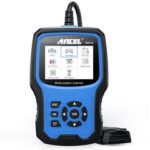Integrating an OBD2 adapter with your Android car PC opens up a world of possibilities, transforming your in-car entertainment system into a powerful diagnostic and performance monitoring tool. For car enthusiasts and everyday drivers alike, understanding your vehicle’s health and performance data is invaluable. Let’s explore how an Android Car Pc Obd2 setup can revolutionize your driving experience, and why the Kiwi 3 adapter stands out as the perfect choice.
Unleashing the Power of OBD2 on Your Android Car PC
OBD2 (On-Board Diagnostics II) is a standardized system in most modern vehicles that provides access to a wealth of data from your car’s computer. Connecting an OBD2 adapter to your car’s OBD2 port and pairing it with your Android car PC allows you to tap into this data stream. Imagine having real-time insights into your engine’s performance, fuel efficiency, and even potential issues, all displayed conveniently on your car PC screen.
With the right apps on your Android car PC, an OBD2 adapter becomes much more than just a diagnostic tool. It becomes a comprehensive vehicle management system. You can monitor crucial parameters such as engine temperature, RPM, speed, fuel consumption, and much more. This data can be used for:
- Real-time Performance Monitoring: Track your engine’s performance metrics to optimize driving habits and identify areas for improvement.
- Vehicle Diagnostics: Read and clear diagnostic trouble codes (DTCs), allowing you to understand and address check engine lights without immediately visiting a mechanic.
- Data Logging: Record driving data for later analysis, useful for tracking fuel efficiency over time or analyzing performance on track days.
- Customizable Gauges: Create personalized dashboards displaying the vehicle parameters most important to you.
Why Kiwi 3 is the Ideal OBD2 Adapter for Your Android Car PC
When it comes to choosing an OBD2 adapter for your Android car PC, the Kiwi 3 stands out for several compelling reasons. It’s engineered for performance, ease of use, and broad compatibility, making it a superior choice for tech-savvy car owners.
Unmatched Speed and Performance
The Kiwi 3 boasts exceptional speed, processing data up to 4 times faster than many competitors. This rapid data transfer ensures real-time updates on your Android car PC screen, providing accurate and immediate feedback on your vehicle’s performance. Whether you’re monitoring engine parameters during spirited driving or diagnosing a potential issue, the Kiwi 3 delivers the data you need, when you need it.
Seamless Android Compatibility and Cross-Platform Versatility
Designed for cross-platform compatibility, the Kiwi 3 works flawlessly with Android devices, including Android car PCs. Unlike some adapters that require complex pairing procedures, the Kiwi 3 offers a simple plug-and-play experience. Just connect the adapter to your OBD2 port, launch your chosen Android OBD2 app, and you’re ready to go. This ease of use extends beyond Android, as Kiwi 3 also supports iOS and Windows devices, offering flexibility for users with multiple devices.
Compact and Discreet Design
The Kiwi 3’s incredibly small form factor is a significant advantage. Measuring just 0.68 inches thin when plugged in, it’s one of the most discreet OBD2 adapters available. This low-profile design means you can leave the Kiwi 3 permanently installed in your OBD2 port without it being obtrusive or interfering with legroom.
Wide App Support for Android Car PCs
To maximize the potential of your Android car PC OBD2 setup, app compatibility is crucial. Kiwi 3 is designed to work with a wide range of popular OBD2 apps available on the Google Play Store. This ensures you can choose the app that best suits your needs, whether you’re focused on diagnostics, performance monitoring, data logging, or creating custom gauges. Popular compatible apps include Carista (offering a free trial period) and the dedicated Kiwi OBD app, providing a wealth of features right at your fingertips.

